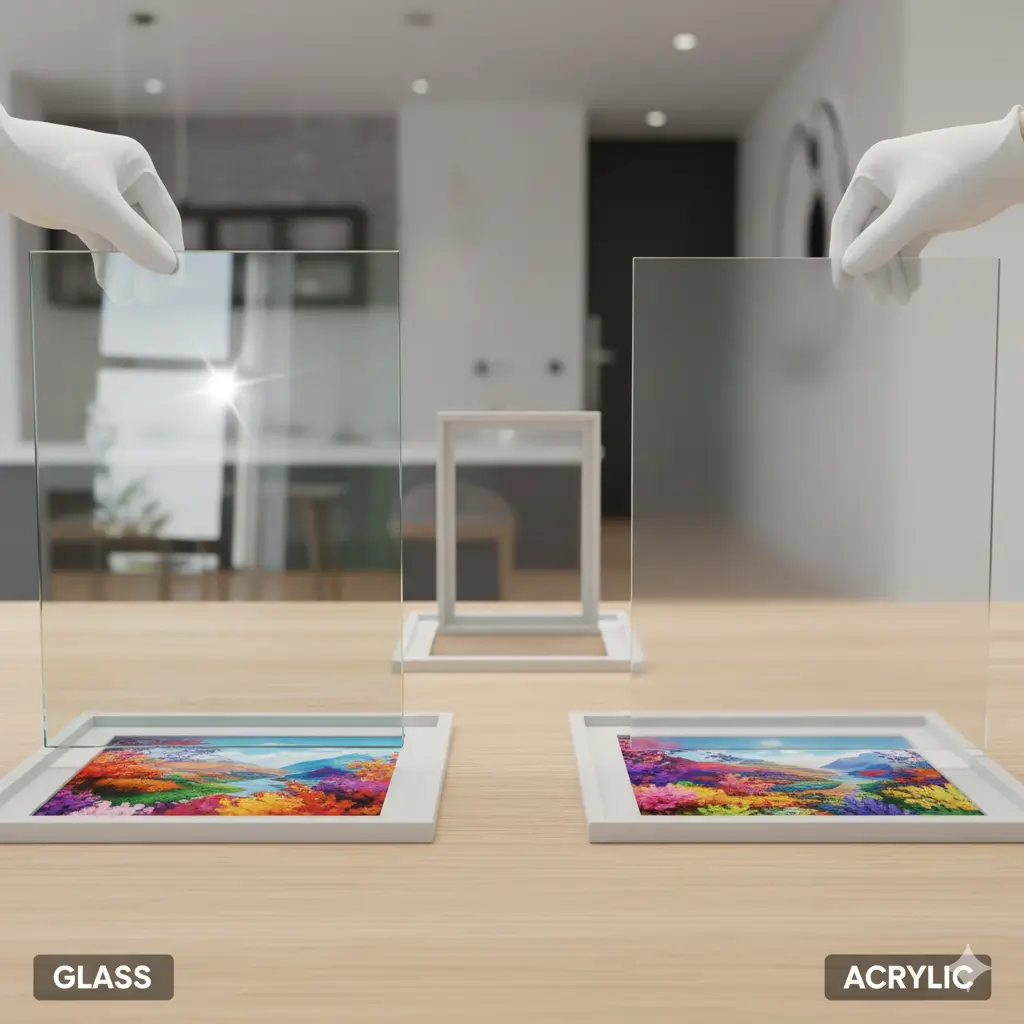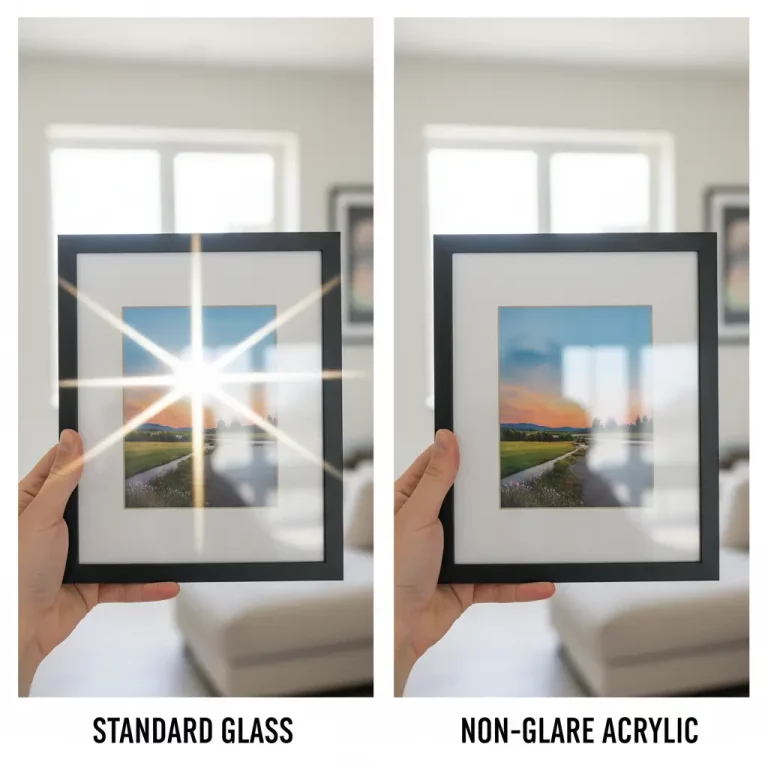When you’ve chosen the perfect photo or piece of art and the ideal frame to complement it, there’s one final, crucial decision to make: the cover material. The transparent layer that protects your image, known as glazing, plays a huge role in both the appearance and longevity of your display. The most common choice you’ll face is between traditional glass and modern acrylic. This decision on an acrylic vs glass frame cover impacts everything from clarity and weight to safety and durability.
Understanding the unique properties of each material is key to ensuring your cherished memories are displayed beautifully and protected effectively. This guide will break down the essential differences between acrylic and glass, helping you weigh the pros and cons to make an informed choice for your specific needs.
Clarity and UV Protection: Seeing Your Art Clearly
The primary job of a frame cover is to be invisible, allowing a clear view of the art behind it. Both glass and acrylic offer excellent clarity, but they do so in different ways.
Glass Clarity
Standard picture frame glass offers great transparency. However, it can have a slight greenish tint, which is most noticeable when viewed from the side. This is due to the iron content within the material. While often unnoticeable, this can subtly affect the color balance of the artwork behind it. More expensive, museum-quality glass minimizes this tint for purer color transmission.
A significant drawback of standard glass is glare. Its highly reflective surface can act like a mirror in brightly lit rooms, making it difficult to see the image. Anti-reflective glass is available but comes at a much higher price point.
Acrylic Clarity
High-quality acrylic, often sold under brand names like Plexiglas, is exceptionally clear and transmits more light than standard glass—up to 92%. It is also inherently colorless, meaning it won’t alter the hues of your artwork. This superior clarity makes acrylic a favorite for professional galleries and museums.
In the acrylic vs glass frame cover debate, acrylic also has a clear advantage in UV protection. While standard glass blocks some UV rays, acrylic is naturally more effective. Many acrylic sheets are manufactured with built-in UV-blocking properties, filtering out up to 98% of harmful rays that cause photos and art to fade over time. This makes it an excellent choice for preserving valuable or sentimental pieces.
Durability and Safety: Which Is Tougher?
Accidents happen, and the durability of your frame cover can determine whether a small bump results in a crack or a catastrophe.
Glass Durability
Glass is rigid and scratch-resistant, which is a major advantage. It’s less prone to fine surface scratches from everyday cleaning. However, its biggest weakness is its brittleness. Glass shatters on impact, which not only ruins the frame cover but also poses a significant safety risk. The resulting shards can damage the artwork inside the frame and are dangerous to clean up. This makes glass a less-than-ideal choice for high-traffic areas, children’s rooms, or public spaces.
Acrylic Durability
Acrylic is significantly more impact-resistant than glass—about 10 to 20 times stronger. It is shatterproof, meaning if it does break from extreme force, it typically cracks into large, dull-edged pieces rather than shattering into tiny, sharp shards. This makes it a far safer option.
The trade-off for this impact resistance is that acrylic is softer and more prone to scratching. You must use specific cleaners and soft microfiber cloths to avoid causing fine surface scratches. However, for most homeowners, the peace of mind that comes with its shatterproof nature outweighs the need for careful cleaning. The superior safety of acrylic makes it the clear winner in any acrylic vs glass frame cover comparison for homes with kids or pets.
Weight and Handling: A Practical Consideration
The weight of your frame cover can have practical implications, especially for large pieces or when hanging on certain types of walls.
- Glass: Glass is dense and heavy. A large, glass-fronted frame can be surprisingly cumbersome and may require more substantial wall anchors for secure hanging. Its weight also increases shipping costs if you’re ordering frames online.
- Acrylic: Acrylic weighs about 50% less than glass of the same size and thickness. This makes it much easier to handle, hang, and transport. For oversized frames, using acrylic is often a necessity to keep the total weight manageable. If you’re planning an extensive display, like the ones in our guide on how to create a stunning gallery wall, the lighter weight of acrylic can make the project much more manageable.
Cost: How They Compare
For many, the budget is a deciding factor. In the acrylic vs glass frame cover showdown, the cost can vary.
- Standard Glass: At smaller sizes, standard glass is typically the most affordable option. It is widely available and inexpensive to produce, making it the default choice for most ready-made frames.
- Standard Acrylic: Basic acrylic sheets are often slightly more expensive than standard glass, especially at smaller dimensions.
- Specialty Options: The pricing dynamic shifts when you move into specialty materials. Anti-reflective or UV-protective glass is significantly more expensive than standard glass. Conversely, UV-protective acrylic is often more affordable than its glass counterpart, offering superior protection for a better price. For large custom frames, acrylic may also become more cost-effective due to lower shipping expenses.
Making the Right Choice: A Summary
Deciding between an acrylic vs a glass frame cover depends entirely on your priorities, budget, and where the frame will be displayed.
Choose Glass If:
- You are framing a smaller piece (under 11×14 inches).
- Your budget is the primary concern for a standard frame.
- The frame will hang in a low-traffic, secure location.
- Scratch resistance is your top priority.
Choose Acrylic If:
- You are framing a large or oversized piece of art.
- Safety is a concern (e.g., in a child’s room or public space).
- You are shipping the frame.
- Maximum clarity and UV protection for your artwork are important.
- The piece will hang in a bright room, and you want to minimize glare (as acrylic is less reflective than standard glass).
For more insights on making your artwork look its best, consider exploring the differences between display styles, such as in our article comparing framed vs unframed photos.
Ultimately, both materials can serve you well. By weighing these factors, you can confidently select the cover that will best protect and showcase your art for years to come.





